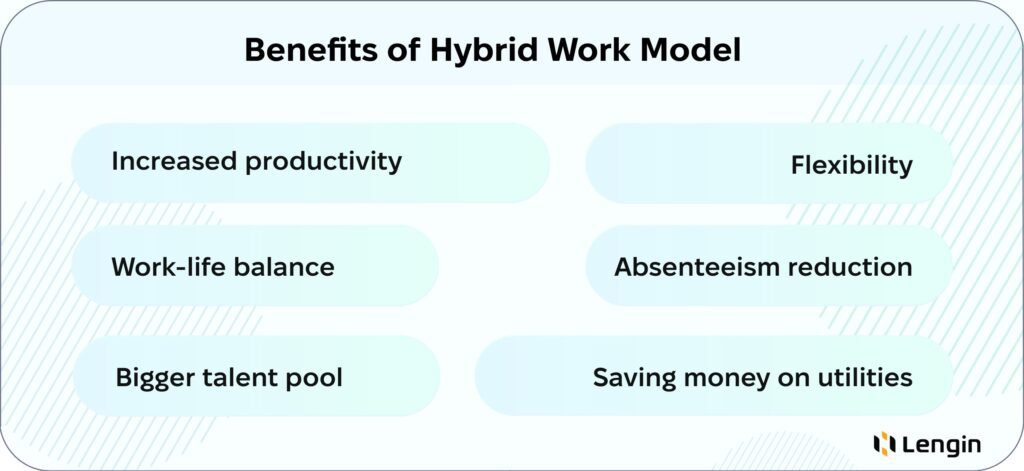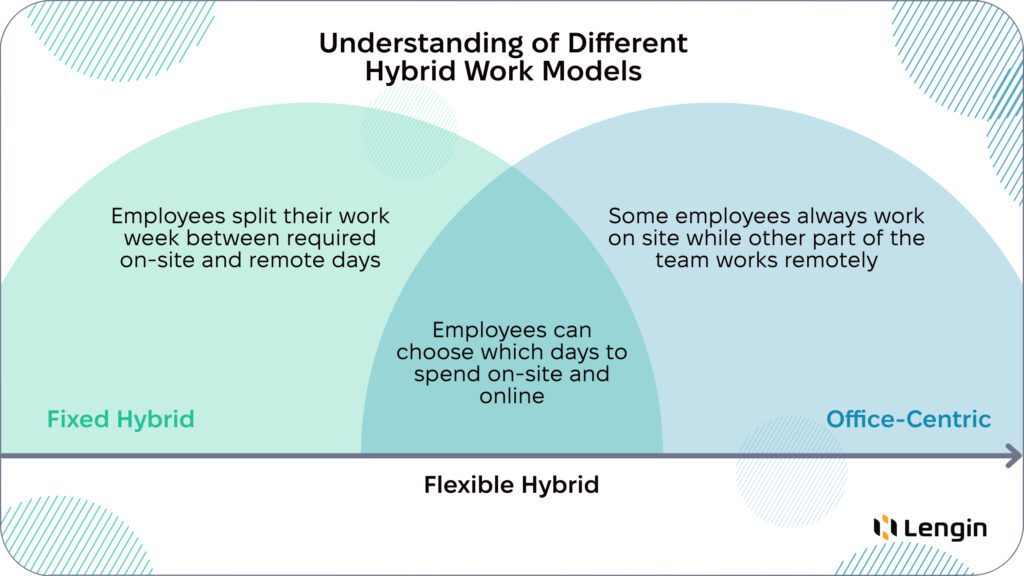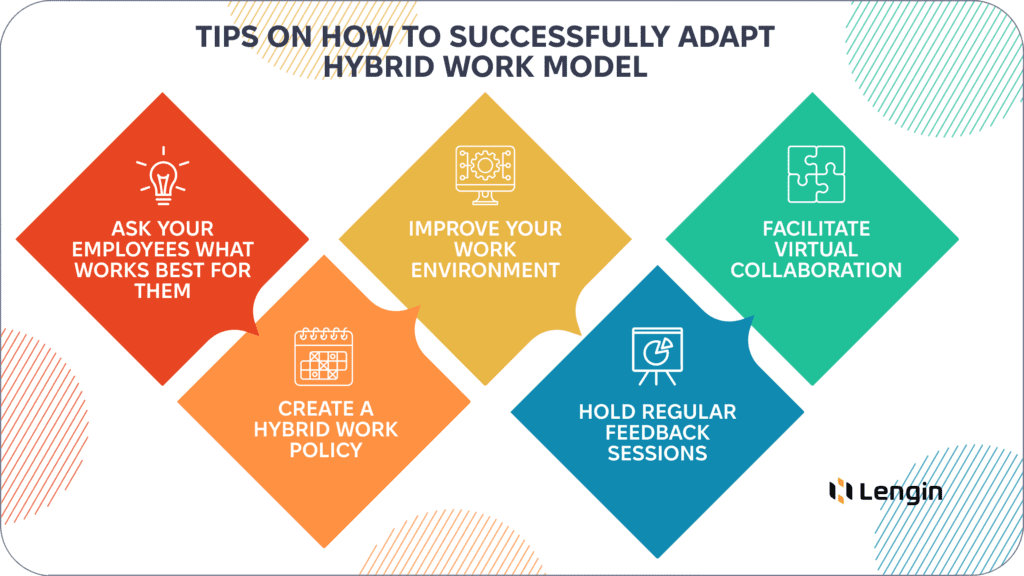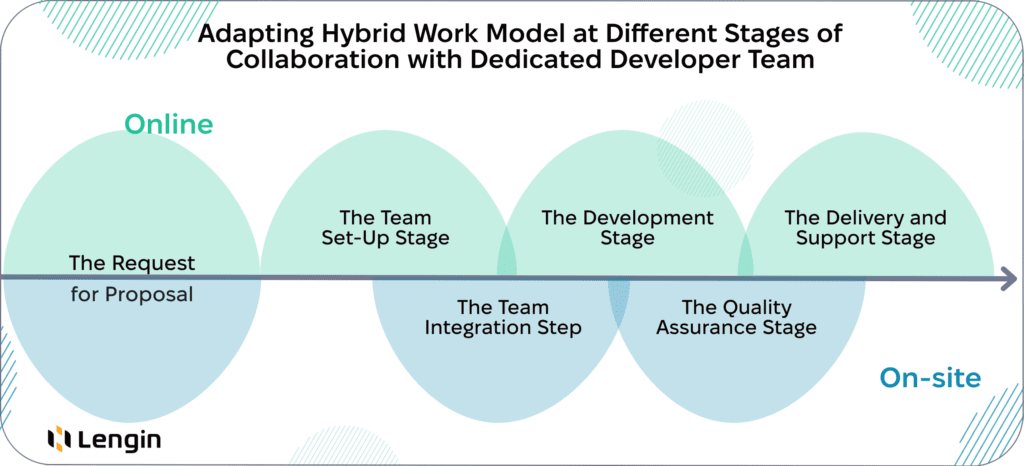The definition of the hybrid working model is hidden in the name itself. The term “hybrid” means something mixed. More specifically, the hybrid work model is a combination of different models of work organization, which was created as an adaptive response to a change in the economic or market environment or to improve Key Performance Indicators.
So, it means a unique style of work organization which includes online and offline types of work. That can be either gradation by teams (for example, clients` support managers team works remotely and the marketing team works in an office) or by separate workers, as well as partial sharing of days working online and offline by each worker (two days remote, three days in office).

According to Forbes Advisor, which statistic is based on information from such reliable sources as WFHRResearch, Upwork, Linkedin, Buffet, Indeed, ApolloTechnical, PewResearch, PRNewswire, and others, in 2023, a significant 28.2% of employees have adapted to a hybrid work model since this model combines both home and in-office work, offering flexibility and maintaining physical presence at the workplace.
This up-and-down-going trend is connected with the pandemic of COVID-19. That was a “wake-up call” for implementing hybrid working models and starting its trip to popularization in the modern world of work organization processes. As known, when the coronavirus was detected in 2019, all offices, all kinds of public transport, the majority of shops, and all other public places were closed and unavailable for visits.
Therefore, businesses had to react and adjust. The central part of employees started to work entirely remotely. That was the moment when both entrepreneurs and workers realized the power and advantages of organizing work online.
A hybrid working model can satisfy the requirements and needs of working processes, increasing KPI and bringing advantages to both the client and the dedicated development team.
Table of Contents:
Benefits of Hybrid Work
There are lots of advantages to using the hybrid working model. Let’s drill into each of them.

Bigger Talent Pool and Flexibility
Collaboration of sharp technological gap, digitalization in all life fields, and transport sector development led to massive business and life globalization. The hybrid work model expands the horizons of workforce selection and engages candidates from anywhere in the world. This will enable you to improve the quality of work, search for employees who suit your needs best, and collaborate with teams located thousands or even tens of thousands of kilometers away.
Also, this type of work provides the opportunity for already working personnel to perform tasks while being far from the office, thus making the place of work (company) more attractive for both short- and long-term cooperation.
This way of organizing work also allows you to be more flexible. So, if you need to leave urgently due to a life situation, there is no need to stop the work process and be tied to one workplace.
Work-life Balance
It’s not a secret that work nowadays is more busy and more stressful, so it’s getting harder and harder to keep a work-life balance.
During the last decades, such term as “burnout” appeared, which means getting overstressed at work, causing mental exhaustion and loss of empathy that can lead to long-term deep depression or mental disorders. In Japan, there is even a term “Karoshi,” which means “overwork death.” This term describes the sudden death of a worker caused by stress and fasting at work.
The hybrid model can help to reduce stress, let employees and entrepreneurs provide healthy and relevant schedules, spend more time with family or friends, combine work and hobbies, and allow single parents to care about their children and still work, so the labor market doesn’t lose good specialists just because of different kinds of life situations.
Saving Money on Utilities
This is a massive benefit for businesses, rapidly experienced during the lockdown caused by COVID-19. At the time when it was not possible to visit offices and work in the same area with other people, businesses had to adjust and tried to organize work remotely. That was the moment all agents of the working process realized the benefits of going online.
Now, companies don’t have to rent offices permanently, just rent workspaces when needed. It leads to reduced losses on rent, electricity, security systems, office consumables, and others. So, a hybrid working model is also more profitable for businesses.
Increased Productivity
This benefit is divided into two parts. The first one was already touched in the “work-life balance” advantage. Reducing stress at work and being more flexible with time during the working day significantly increases workers’ productivity. They are more inspired and motivated for work.
For example, offices like Google’s contain gyms, playing areas, cozy workspaces, let employees take their pets to work, and so on. This is made to diversify working days and reduce stress. Smaller companies or ones who choose another way of working organization can confidently try hybrid working models and let employees diversify their working day by themselves.
The second part is connected with different types of human temper. Tasks and working processes can take extra time by different specialists. And, of course, the environment is also essential. An employee can be very professional, but it can be hard to work surrounded by people, or they are more productive in the late evening when the office is already closed. They will be more successful in completing tasks and staying in a calm atmosphere at home.
That’s how hybrid work models increase productivity.
Absenteeism Reduction
As mentioned before, there are different life situations, and sometimes employees have to be absent from work because of a doctor’s appointment, caring about children or family members that require special care, or any other situation.
Providing a hybrid model lets the skilled labor force stay in the work process despite their private life situation and keep in touch no matter what. Tasks can be done before the deadline, and the management of the company will not be involved in employees’ personal lives by approving time off for them.
There is no doubt that the hybrid working model contains lots of benefits, both for businesses and employees. That’s why it’s getting so viral and certainly has a big future in further economic activities. The best thing is that every company can choose the type of hybrid work that suits their needs best.
Main Hybrid Work Models

As previously mentioned, there are diverse ways to combine online and offline work.
Office-centric HWM
An office-centric workplace establishes the physical office as the primary location of most full-time work functions.
That model involves a tiny part of employees in remote jobs. At the same time, most of the workforce stays at the office.
For example, at TAC Insurance, most workers stay at the office, but some of the HR team members, for example, can stay at home and search for candidates remotely.
Remote-first
This type is almost entirely remote or almost fully virtual. The company provides physical office spaces just in cases of necessity, but not all the time and not even a fixed time. Usually, working hours are not regulated and give employees a chance to complete work from any place in any part of the world.
This type of hybrid work is the most popular among IT companies.
Fixed hybrid
Fixed HWM means that the company regulates and schedules work online and offline. For example, employees have to work from Monday to Thursday in the office, and Friday is always a remote day. This HWM opens an opportunity for workers to extend their time for themselves on weekends without disturbing the working process.
Fixed hybrid is suitable for any company.
Flexible hybrid
A genuine hybrid workplace provides employees with the flexibility to accommodate their individual work styles, collaboration requirements, and job responsibilities while still meeting the organization’s needs and upholding its cultural norms.
Since there is no universally applicable solution, each hybrid workplace is unique. Some offices may have a structured approach to help employees decide how to divide their time between in-office and remote work. In contrast, others may give employees the freedom to choose when they come to the office and work remotely.
Marketing agencies mainly use this kind of HWM. There is always a workplace for company members, but it lets employees decide where to work.
The type of HWM depends on the needs and requirements of a company and has to be chosen after detailed management analysis. The correct choice will increase productivity, improve corporate culture, and provide long-term working relationships with a highly qualified workforce.
The Secret of Successful Hybrid Work with Dedicated Developer Teams
Developers have become more successful and productive with the shift to hybrid models. This mainly happens due to globalization and the expansion of the pool of labor resources. Also, developers need long-term concentration, which implies the need for their own time management.
According to statistics, in 2022, 74% of American companies already used or started using a hybrid work model. But for HWM to work correctly with a dedicated developer team, it has to be implemented correctly.
Key factors defining success in using HWM are increasing productivity, optimization of the working process, loss reduction, good cooperation both between workers and teams, high-quality final product, post cooperation, and getting more projects for the team in the long term.

Here are some tips on how to successfully adapt HW for a dedicated developer team:
- Ask your employees what works best for them.
Interview your employees before moving to a particular hybrid work model. Learn about the types of spaces that promote productivity. Are they more productive when working in a quiet environment? Do expansive open spaces make collaboration and brainstorming easier? - Create a hybrid work policy.
Create a hybrid policy that takes survey responses into account. Should each team have its own policy, or do policy changes make more sense? Most importantly, make sure your policy fits the needs of your staff and organization. - Improve your work environment.
Adapt your office to meet the needs of a modern workforce. Create modest, quiet spaces for people, such as video conferencing, and double the large meeting spaces for face-to-face team meetings. - Hold regular feedback sessions.
Frequent one-on-one meetings between managers and team members, as well as between managers and HR, can help with communication. They are also critical for recognizing the changing demands of the workforce and ensuring that your employees feel heard. - Facilitate virtual interactive collaboration.
While people with hybrid work schedules may not interact with colleagues daily, the partnership allows people to make announcements, thank colleagues for outstanding performance, and debrief team members on critical issues that arise. Video conferencing is a crucial component of remote and hybrid collaboration because it allows people to capitalize on the complexities of face-to-face meetings (even if only from the neck up).
Why Hybrid Work Model for Dedicated Developer Teams?
Most notably, it is to understand why hybrid working models are chosen for dedicated developer teams. This model passes perfectly for large-scale, complex, long-term maintenance and support projects, as well as ones that involve emerging technologies or have tight deadlines.
So why is the hybrid working model suitable for that kind of team? The answer lies on the surface of implementation and realization of the working process. According to its stage, different types of work (remote or offline) are more relevant.
Lengin has been following key steps for providing quality hybrid work for development teams and delivering the best result possible.
- The Request for Proposal.
This stage includes composing a request with tasks and targets, applying it to a source where developer teams can see it, and choosing and making the first communication between client and team. At this stage, after online contact, there has to be a private face-to-face meeting to discuss details. - The Team Set-up Stage.
At this stage, the team gets more specific requirements and is subject to an assessment of its capabilities and the necessary personnel to complement it. This stage can be completed online while maintaining constant contact for discussing further actions. - The Team Integration Step.
This stage involves introducing the team to the client and other teams and familiarizing them with the company’s policies. Timeframes and budgets are also agreed upon. Here, working in an office is the most significant, if not full-time, at least part-time. The need reflects on the necessity of directly involving the team in all levels of working processes, making and correcting targets and tasks of the team, and the necessity of immediate communication. - The Development Stage.
The time of direct work on the project when teams complete tasks and goals. At this stage, almost entirely remote work is possible because, at this time, the team realizes the targets and tasks made in the previous step. Correction, editing, controlling, and general communication can be carried out just through present internet resources. - The Quality Assurance Stage.
A step in which the scope and quality of work are checked, deadlines are monitored, adjustments are made, and the project is brought to the final step. Generally, live contact is better if there are some points to check or to fix.
The Delivery and Support Stage.
The finished project is delivered to customers, and post-support is provided. This stage can be accomplished just through online communication and keeping in touch with clients remotely.

Challenges of the Hybrid Work Model
But, there is also a “but.” Obviously, nothing can be perfect, so there are some risks in hybrid working that can be mitigated by careful management.
For example, in remote-first HMW, there is a communication deficit. Working from home, employees feel isolated. Even daily online meetings cannot replace live interaction with colleagues. As a result, going to the office becomes almost a holiday for remote workers.
The next problem is technical. For example, sudden internet connection interruptions or power outages can lead to deadlines being missed. Similar situations occur in the office, but a technical support specialist will promptly deal with arising problems.
Another risk is connected with information leakage. Most companies allow employees to work from home on their own computers that do not have security software installed. As a result, personal data and trade secrets can get public.
And last but not least, distractions for household chores. It is good if the employee allocates a separate room for work. But in practice, this luxury is only available to some. Sometimes, it is necessary to perform work duties against the background of a working TV and noisy children’s games, which reduces concentration level. Nevertheless, these dangers can be minimized by the following steps:
- Actively practicing team building activities.
- Organizing corporate events.
- Participation of companies in providing home employees` workplaces with the technical equipment
- Creating infrastructure for fast corporate communication.
- Providing digital resources for information search.
All those steps will lead to just positive aspects of implementing hybrid work models, as many companies have already done.
Business cases
Lots of companies worldwide already successfully practiced HWM. Google and Slack are the most sought-after.
It’s not a secret that Google has one of the best corporate cultures in the world. Due to the recent introduction of a fixed hybrid model, this digital giant is bringing people back to the office without sacrificing work flexibility.
They are asking employees to be in the office only three days a week, and in addition to their standard vacation, they are now given four weeks to work from home.
For the following example, let’s take the smaller company to see that HWM is suitable not just for business giants.
Slack
Slack is a Technology, software, and services company located in California. It contains about 2600 employees. Since June 2020, the company has been working on a flexible hybrid model.
“With time, we will mainly use offices for collaborative work and social interaction.”
Cal Henderson, Slack CTO and co-founder
Today, Slack employees report feeling engaged regardless of where they work. They are measured by results, not time spent at their desk.
The Future of Work: Trends, Tendencies, Predictions
Companies worldwide tend to use hybrid working as a model that is becoming increasingly popular. Some of the largest companies in the world have already used hybrid strategies that have resulted in happier and more efficient workers, as well as cost savings.

According to WorkLab’s Work Trend Index Annual Report, 57% of remote employees consider a shift to hybrid, while 24% of companies envision working remotely only. Compared to pre-pandemic numbers, these changes will roughly double the number of employees who work remotely for at least part of the week, creating an office environment unlike anything we’ve ever seen.
Managers and staff need time to adapt to a hybrid work pattern quickly. Ensure your team is prepared for any challenges or trends in hybrid working you may face beyond next years.
Of course, not all business types can implement hybrid models for all workers, but as modern trend shows, in the next five years, applying HWM will reach its possible maximum.
It caused the development of more and more tools for better collaboration, for example, digital workplaces like Switchboard.
Conclusions
Whatever model companies choose, today’s workforce has demonstrated that hybrid work isn’t going anywhere. And if you want to retain and hire great employees, flexible alternatives are a must.
Of course, there are challenges with remote and hybrid work, such as communicating over long distances, tracking people’s information between locations, and so on.
Technology is essential to bridging the gaps and ensuring the success of any hybrid work project. It can help with everything from communicating with people worldwide to automating the onboarding process for new employees, cross-referencing schedules, and strengthening relationships within an organization.
Contact us and embrace all the benefits of adapting a hybrid work model with a dedicated developer team!